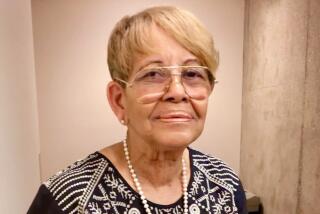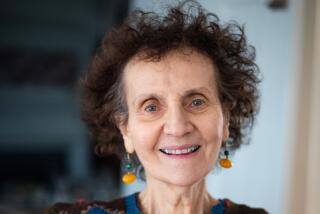Doris Tennant Westcott, 98; USC’s First Helen of Troy, Veteran Compton Educator
- Share via
Even if Doris Tennant Westcott had not become a pioneering educator in Compton or served with distinction in the WAVES during World War II or helped students in financial need after her retirement, she would have still had a historic place at USC.
For Doris Tennant Westcott, class of 1930, was the school’s first Helen of Troy.
Westcott, who died May 16 at age 98, will be honored Wednesday at a memorial service at the university, where she made national headlines in 1928.
An active presence on the USC campus, Westcott was elected Helen of Troy in 1928 and again the next year.
As Helen of Troy, she represented the school at social functions and was queen of the annual women’s Hi-Jinks program, which was sponsored by the school’s YWCA and part of the annual homecoming festivities, said Claude Zachery, an archivist at USC.
The Hi-Jinks was an evening of song, dance and dramatic sketches presented by sororities and women’s organizations, and staged at Bovard Auditorium.
Assisted by the Amazons honor society, she took part in the program’s prologue by opening the gates of Troy. She also would ride on a float in the homecoming parade.
Years later, she remembered that when she needed a costume for her debut as Helen, someone “took the green velvet draperies from the Elisabeth von KleinSmid Residence Hall and made me a robe for the affair.”
The name Von KleinSmid had a lot to do with her going to USC in the first place.
Born in Fayetteville, Ark., Doris Tennant was 3 when her family moved to Fullerton. After receiving her primary and secondary eduction in Fullerton, she was ready to go off to college and was planning on UC Berkeley.
But the president of USC, Rufus Bernhard von KleinSmid, spoke to her high school graduating class in 1926 and told the students that they could be anything they wanted to be.
His comments impressed her enough to switch to USC, where she majored in physical education and minored in Spanish, becoming fluent in the language and using it throughout her life.
After graduating in 1930, she took an offer from the Compton school district as a teacher on the combined high school and junior college campus. By the late 1930s, she had switched to administration and was the principal of Willowbrook Junior High. She would spend her entire professional career in the Compton school district.
During World War II, she was recruited to join the WAVES -- Women Accepted for Volunteer Emergency Service -- and, after taking a leave of absence from Compton, traveled to Smith College in Massachusetts for training. She graduated with the rank of lieutenant junior grade and eventually headed up the 12th Naval District, commanding the WAVES in six Western states from her post in San Francisco.
After her discharge, she returned to USC for her master’s degree in education. And she went back to Compton to live and work as the principal of one of the state’s first continuation high schools. In 1953, she was named principal of Compton High School, one of the first women in the state to hold such a position.
She stayed in that job until she retired in 1970 and moved to Long Beach.
During her tenure in Compton, she helped break racial barriers in the 1960s by hiring the district’s first African American teacher.
Over the years, she invested wisely and accumulated assets that allowed her to fund scholarships at Long Beach City College and the USC Leonard Davis School of Gerontology, USC Rossier School of Education and Mexican American Alumni Assn.
Her marriage in the 1930s to Jack Westcott, a former USC football player, ended in divorce. They had no children and she left no survivors.
Wednesday’s memorial service will be from 3 to 5 p.m. at the Ethel Percy Andrus Gerontology Center on the USC campus.
*
More to Read
Sign up for Essential California
The most important California stories and recommendations in your inbox every morning.
You may occasionally receive promotional content from the Los Angeles Times.










